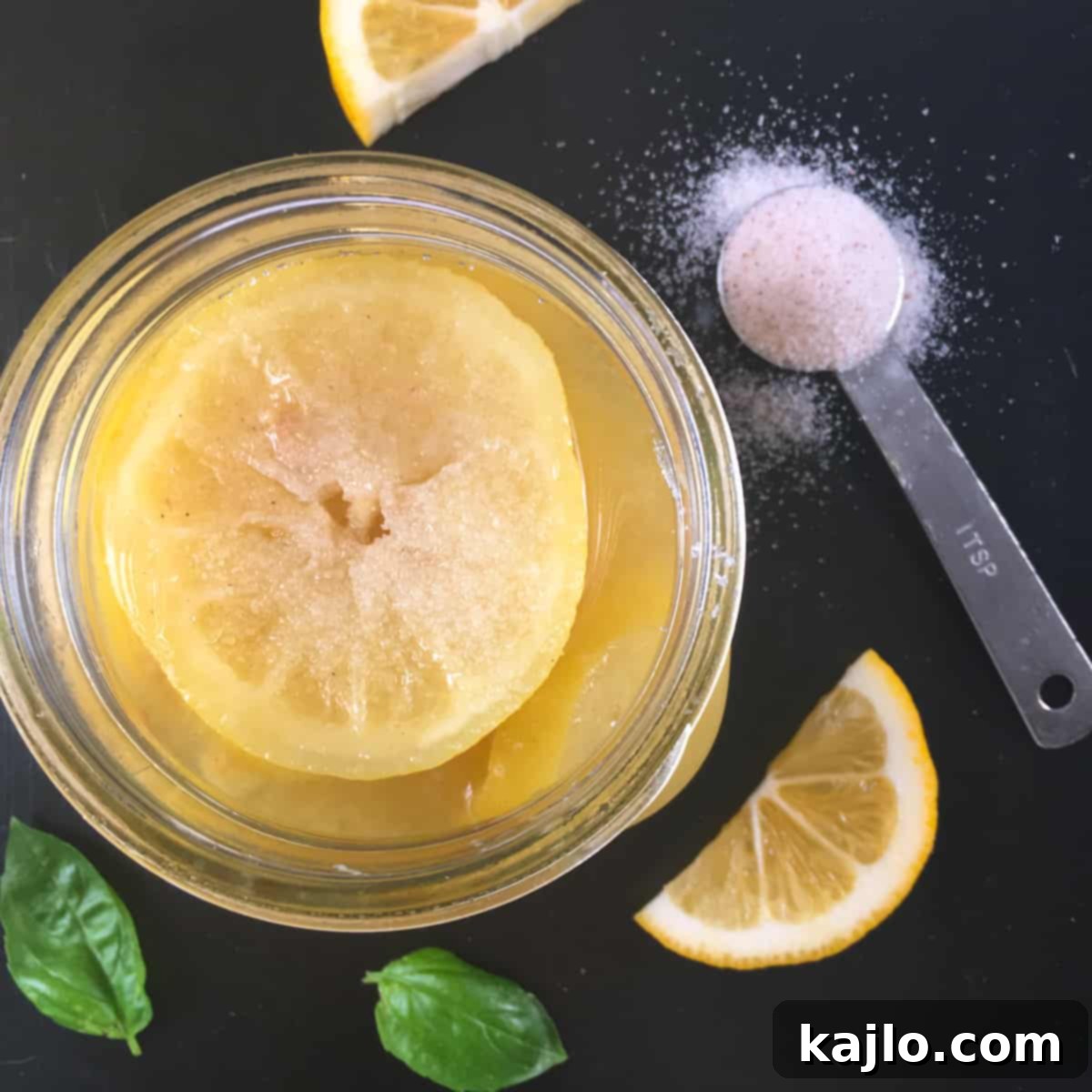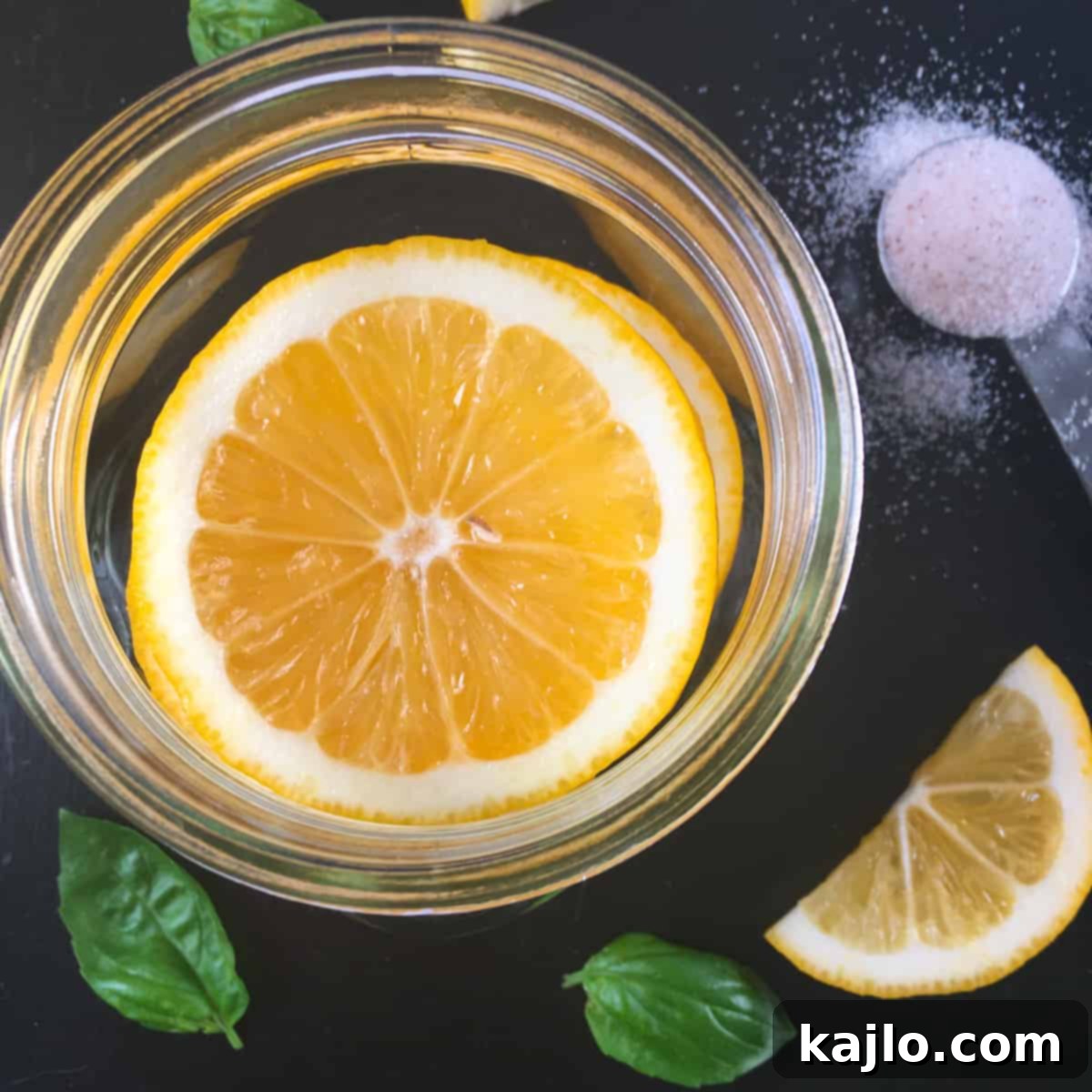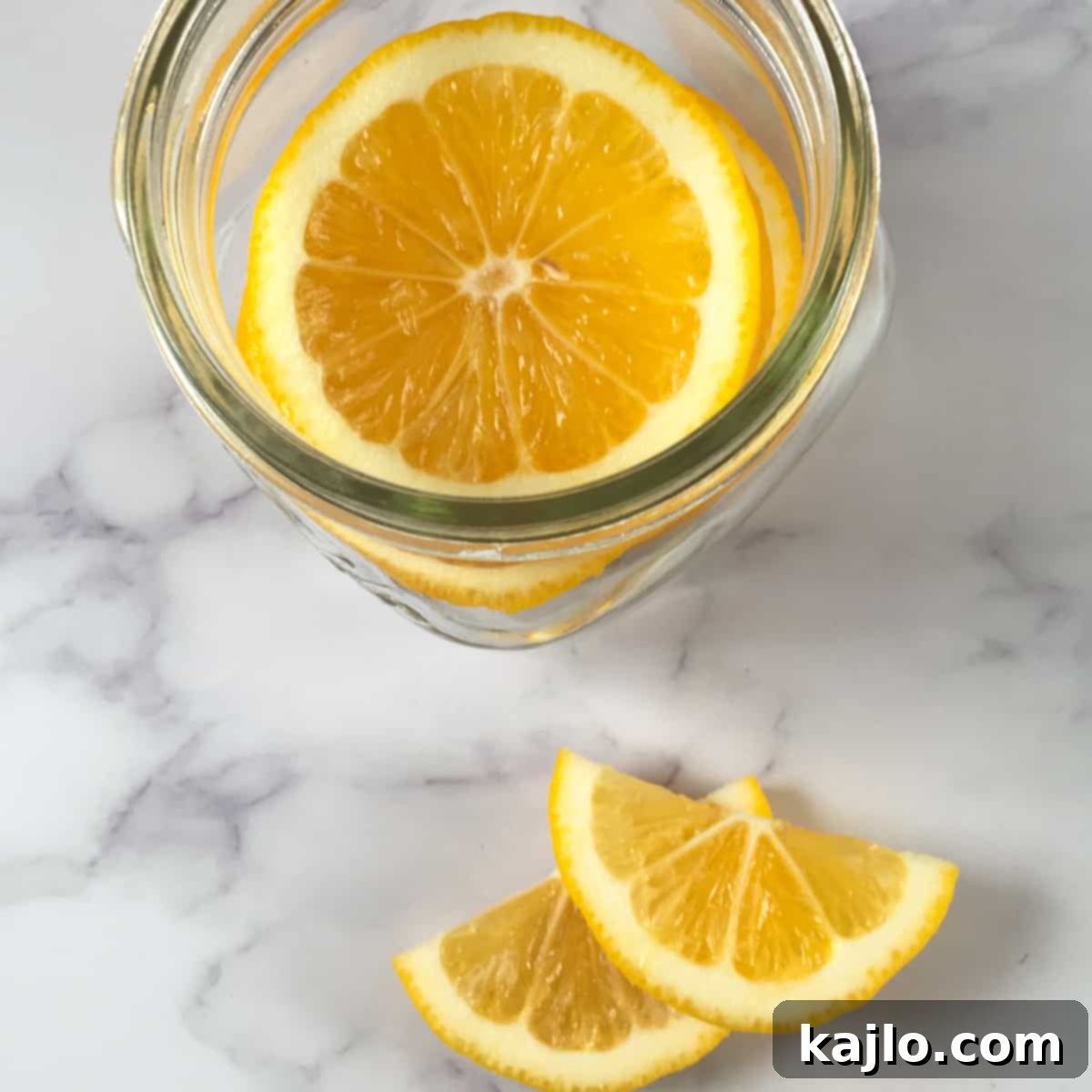Unlock the incredible world of **fermented lemons**, a time-honored method for preserving this versatile citrus fruit for long-term enjoyment. This simple, two-ingredient recipe—fresh lemons and sea salt—transforms ordinary lemons into a culinary powerhouse, brimming with complex, bright, and savory flavors. Perfect for a myriad of special diets including keto, vegan, gluten-free, and dairy-free, preserved lemons are an essential ingredient for elevating dishes, from traditional Moroccan tagines to everyday salads and sauces. Dive into this guide to master the art of making **preserved lemon slices**, discover creative ways to **use fermented lemons**, and understand the subtle nuances that make them a pantry staple.

When discussing lemon preservation, the term “preserved lemons” most commonly refers to **salted lemons** that have undergone lacto-fermentation. This natural process involves beneficial bacteria breaking down sugars, creating lactic acid that not only acts as a preservative but also develops unique, deep flavors. While other methods exist—such as canning lemon curd for shelf-stable storage—lacto-fermentation stands out for its simplicity and the distinct umami notes it imparts.
You might wonder about the difference between **pickled lemons vs. preserved lemons**. Generally, the terms are often used interchangeably, especially when referring to salt-fermented varieties. However, in some contexts, pickled lemons might imply lemons cooked in vinegar, a method that offers a different flavor profile and texture. For our purposes, we focus on the raw, salt-fermented technique that yields truly “preserved lemons.” Due to lemons’ naturally high acidity (low pH), the risk of harmful bacterial growth, such as botulism, is exceptionally low across these various preservation methods, making it a safe and rewarding culinary endeavor.
This comprehensive guide will walk you through each step, from selecting the right ingredients to mastering the fermentation process and exploring countless culinary applications. For those eager to jump straight to the kitchen, a detailed recipe card is provided towards the end of this article. However, reading through the expert tips and explanations will significantly enhance your understanding and success in making the best **homemade preserved lemons**.
🍋 Essential Ingredients for Fermented Lemons
Making **fermented lemons** is remarkably straightforward, requiring only two core ingredients, easily found in most grocery stores. The quality of these ingredients, however, plays a crucial role in the final product’s flavor and safety. Here’s what you’ll need:
- Fresh Lemons: You’ll need approximately 2 large lemons for slicing, plus additional fresh lemons (enough to yield ¾ cup of juice). Organic lemons are highly recommended as you will be consuming the rind, and avoiding pesticides is ideal.
- Salt: 2 tablespoons of canning salt, pickling salt, or fine-grind sea salt. This is a non-negotiable ingredient for both flavor and preservation safety.

Choosing the Right Salt
The type of salt you use is paramount for successful and safe fermentation. **Avoid iodized salt or coarse-grind salt.** Iodine can interfere with the beneficial fermentation process, potentially inhibiting the growth of desirable lactic acid bacteria. Coarsely ground salt, on the other hand, measures differently than fine-ground salt by volume. Using it might result in too little salt, compromising the safety and efficacy of the ferment. Fine-grain salts dissolve more easily and distribute evenly, ensuring consistent preservation.
For ultimate precision, especially if you’re new to fermentation, you can weigh your lemons and use 2% of their weight in salt. However, for lemon ferments, the provided volume measurements are generally reliable and simpler to follow, ensuring you have the minimum amount of salt required for a safe ferment.
Selecting Your Lemons
While any fresh, good-quality lemon will work, **Meyer lemons** are a fantastic choice for this recipe. Their thinner skin, sweeter juice, and distinct floral aroma create an exceptionally fragrant and delicious preserved lemon. If Meyer lemons are unavailable, standard Eureka or Lisbon lemons will yield excellent results as well. The key is to choose firm, blemish-free lemons with bright, vibrant skins, as much of the flavor will come from the peel.
Beyond the lemons you slice, you will need extra lemons to produce ¾ cup of fresh lemon juice. This juice forms the brine, a critical component for submerging the lemon slices and initiating fermentation. **Bottled lemon juice is not a suitable substitute**; its pasteurization and potential additives can hinder the delicate microbial balance needed for successful lacto-fermentation. Freshly squeezed juice provides the natural enzymes and nutrients necessary for the process. In essence, just two readily available ingredients are all it takes to embark on this simple yet rewarding culinary journey.
Essential Equipment for Fermenting Lemons
While simple, having the right tools can make your **homemade preserved lemons** experience smooth and successful:
- Wide-Mouth Pint-Size Glass Mason Jar: The wide mouth makes packing lemons easier and accommodates most fermentation lids. The jar’s “shoulders” are also helpful in keeping lemon slices submerged beneath the brine.
- Fermentation Kit with Jar Weights and Airlock Lids: These are highly recommended, especially for beginners. Jar weights ensure your lemons remain fully submerged in the brine, preventing mold growth. Airlock lids allow gases produced during fermentation to escape without letting outside air in, creating an anaerobic environment crucial for lacto-fermentation and minimizing contamination risks. Investing in a good fermenting set can drastically improve your success rate and prevent ferments from going bad.
- Juicer: A manual lemon juicer works perfectly, but an electric juice extractor or even just your hands can get the job done.
➕ Step-by-Step Guide: How to Make Fermented Lemons
Learning **how to ferment lemons** is a simple process. Follow these detailed steps to create your own batch of flavorful preserved lemons:
- Prepare Your Jar: Before beginning, thoroughly clean and sanitize your wide-mouth canning jar. Running it through a hot dishwasher cycle is sufficient. Sterilization, which kills all microbes, is not strictly necessary for lacto-fermentation as we rely on beneficial bacteria, but a clean environment is vital to prevent undesirable mold or spoilage.
- Wash and Juice Lemons: Rinse your whole lemons under cool water and pat them completely dry. Next, juice enough additional fresh lemons to yield ¾ cup of fresh lemon juice. This will form the brine.
- Slice the Lemons: Take two of your main lemons and carefully cut off both the blossom and stem ends. These end pieces ferment slightly slower and can be set aside for other culinary uses (e.g., infused water, candied peels). Slice the remaining lemon into uniform ¼-inch thick rounds. Hot tip: While some recipes suggest quartering lemons, slicing them into rounds typically works better for even fermentation and makes them easier to use in recipes later.
- Salt the Lemon Slices: Generously rub each lemon slice on all sides with your chosen fine-grind salt. Do not skimp on the salt! The salt is critical for creating an environment where beneficial lactic acid bacteria thrive while inhibiting harmful bacteria. It also draws out moisture from the lemons, contributing to the brine.
- Pack the Jar: Tightly pack the salted lemon slices into your prepared jar. Press them down firmly to remove any air pockets. It’s important not to overfill the jar; the slices must remain below the lip, leaving sufficient headspace for the brine and any fermentation activity. Use fewer slices if needed to ensure proper fit and submersion.
- Cover with Lemon Juice Brine: Pour the fresh lemon juice over the packed lemon slices until they are completely submerged. This full submersion is absolutely crucial for preventing mold growth, which thrives in oxygenated environments. You might not need all of the ¾ cup of lemon juice; the amount will depend on how tightly your lemons are packed.
- Secure with Weight and Airlock: Place a glass fermentation weight on top of the lemons to keep them pressed below the liquid level. Then, screw on an airlock lid. If your specific airlock lid requires water to create a seal, fill it according to the manufacturer’s instructions. This setup ensures an anaerobic environment for successful fermentation.
⏲️ Fermentation Time and Temperature for Preserved Lemon Slices
The fermentation process for **preserved lemon slices** requires patience and the right environment. Typically, you will **ferment your lemons** for 4-5 weeks at room temperature, ideally between 60-70 degrees Fahrenheit (16-21°C). This temperature range encourages the optimal growth of lactic acid bacteria responsible for the transformation.
During this period, you may observe bubbles forming in the jar, which is a sign of active fermentation. The brine might also become cloudy, and the lemons will soften and take on a more translucent appearance. Once the fermentation period is complete, move the jar to the refrigerator. The cooler temperatures will significantly slow down the fermentation process, preserving the peak flavor and texture of your **salted lemons**.
If you are using an airlock lid and a jar weight, your intervention during the fermentation period should be minimal. The only exception is if you are using an airlock lid that requires water and your home environment is particularly dry; in this case, you may need to check and refill the water in the airlock periodically to maintain its seal. For visual cues of “doneness,” compare the appearance of your fermenting lemons to the images of finished preserved lemons in this guide—they should look softened, slightly shrunken, and have a deeper, more uniform color.

🧂 How to Use Fermented Lemons: Culinary Inspirations
Now that you’ve mastered the art of making them, the question becomes: **what do you do with fermented lemons?** Preserved lemons offer a unique depth of flavor that fresh lemons simply cannot match. They provide a bright, tangy, salty, and umami-rich profile that elevates a wide range of dishes. Think of these suggestions as a gateway to your own culinary explorations; the possibilities are truly endless for **recipes for fermented lemons**.
Traditional and Modern Applications
The **fermented lemon peel** is a star ingredient in North African cuisine, particularly in Morocco. It’s almost synonymous with Moroccan chicken tagine recipes and various flavorful stews. A classic example is a Moroccan Chickpea Tagine, where the preserved lemon adds an indispensable layer of authentic, complex flavor that our family absolutely loves.

Beyond traditional dishes, these flavorful **Moroccan lemons** can replace fresh citrus in countless applications. Mince them finely and incorporate them into marinades for poultry, fish, or vegetables. Whisk them into salad dressings for a zesty, briny kick. Blend a small amount into sauces and dips; a preserved lemon aioli or mayonnaise is a revelation. For an unexpected twist, blend a slice or two of preserved lemon into hummus instead of using fresh lemon juice and zest, for a more profound citrusy note.
Consider using preserved lemons in these diverse ways:
- Soups and Stews: Stir a finely chopped piece into lentil soups, chicken noodle soup, or vegetable stews for a burst of savory brightness.
- Salads: Add to grain salads (like quinoa or couscous), lentil salads, or even a simple green salad for a salty, tangy contrast.
- Fish and Seafood: They pair exquisitely with salmon, cod, or roasted shrimp.
- As a Caper Substitute: Finely chop the preserved lemon rind and use it as a salty, tangy alternative to capers in dishes like pasta sauces or butter sauces.
- Dairy Products: Blend a small amount into plain fermented dairy products like kefir or yogurt to create a savory lemon condiment. This can be drizzled over grilled vegetables, used as a dip, or served with roasted meats.
- Roasted Vegetables: Toss with root vegetables like potatoes, carrots, or Brussels sprouts before roasting.
You can use both the fermented lemon rind and pulp in your recipes. While some prefer to use only the rind, the pulp also offers incredible flavor and adds to the overall texture and zestiness. Don’t be afraid to use the entire preserved lemon when cooking. Remember, this ingredient packs a powerful flavor punch and a lot of salt. A little goes a long way! If you find your preserved lemons too salty for a particular recipe, you can rinse them briefly under cold water before using to reduce the sodium content.
🍯 Exploring Other Fermentation Methods: Lemons with Sugar
While our focus here is on salt-fermented lemons, it’s worth noting other fascinating ways lemons can be fermented. For instance, **Korean fermented lemons** often involve fermenting lemons with added sugar, creating a delicious lemon syrup known as “cheong.” This syrup is then used to make refreshing beverages like **fermented lemonade** or warm fermented lemon tea, offering a sweet and tangy experience distinct from their savory, salted counterparts. Similarly, **fermented lemons in honey** is another popular option, where honey acts as the fermenting agent, yielding a probiotic-rich, sweet-sour syrup and tender lemon pieces.
Can Lemons Ferment into Alcohol?
A common question regarding fermentation is whether the process can lead to alcohol production. In the case of salt-fermented lemons, the risk of them becoming significantly alcoholic is minimal. While some very low levels of alcohol might be produced as a byproduct of microbial activity, it’s usually negligible.
To produce a noticeable alcoholic content from lemons, you would typically need to introduce substantial amounts of sugar and often adjust the acidity of the lemon solution to create a more favorable environment for yeast (the primary alcohol producers) to thrive. Homemade fermented lemon drinks that do contain alcohol (like the traditional Finnish Sima) typically have a very low alcohol content, more akin to kombucha than hard liquor. This specific salt-fermentation recipe is designed for preservation and flavor development, not alcohol production, so you can enjoy your preserved lemons without concern.
🌡️ How to Store Fermented Lemons for Maximum Freshness
Proper storage is key to maximizing the lifespan and quality of your **fermented lemons**. Once the initial fermentation period is complete, they are quite stable and can last for a significant time.
How long do fermented lemons last? This **preserved lemon slices recipe** will keep beautifully in the refrigerator for 6-12 months, sometimes even longer, as long as they remain fully submerged in their brine. The cool temperature of the fridge significantly slows down microbial activity, stabilizing the flavor and texture.
Can preserved lemons be frozen? Yes, you can freeze preserved lemons for even longer-term storage. However, given their excellent shelf life in the refrigerator, freezing is often unnecessary for most home cooks. If you do choose to freeze them, transfer individual slices or small batches to freezer-safe bags or containers. This makes it easy to thaw only what you need. Note that the texture might soften slightly upon thawing.
Can preserved lemons go bad? While very durable, preserved lemons can spoil if not stored correctly. The most common issue is mold growth, which occurs if the lemons are exposed to air. Therefore, it is absolutely essential that your preserved lemons remain completely submerged in the brine at all times, even after refrigeration. Using a jar weight, even when storing in the fridge, is an excellent habit to ensure they don’t float above the liquid level. Always visually inspect your preserved lemons before use. If you notice any signs of fuzzy, colorful mold (distinct from thin, harmless kahm yeast), or if they develop an off-odor or texture, it’s safest to err on the side of caution and discard the entire batch. “When in doubt, throw them out” is always the best food safety mantra.
⭐ Fermented Lemons: Nutritional Aspects and Health Benefits
Are fermented lemons good for you? The answer largely depends on your specific dietary needs and what nutritional benefits you’re seeking. From a culinary perspective, they are undoubtedly beneficial. Preserved lemons are low in calories and fat, yet they infuse dishes with an incredible depth of flavor. This allows you to enhance meals without relying on extra fats, sugars, or processed seasonings, making them a fantastic ingredient for those mindful of their caloric intake or following specific dietary patterns like keto or low-carb.
For individuals on low-sodium diets, however, foods fermented in a high concentration of salt, such as these preserved lemons, are generally not an ideal choice. The salt is integral to the fermentation process and contributes significantly to the overall sodium content. While you can reduce some surface sodium by rinsing the lemons thoroughly before use, it won’t eliminate the salt absorbed into the fruit during preservation. For strict low-sodium requirements, fresh lemons remain the better option.

For many, particularly those following a keto, low-carb, vegan, gluten-free, dairy-free, soy-free, or other allergen-free diet, fermented lemons are an excellent fit. They are naturally free from common allergens and comply with a wide range of eating styles, making them a versatile and healthy condiment for nearly everyone else. Furthermore, by utilizing the entire lemon—rind, pith, and flesh—you reduce food waste and gain access to the beneficial compounds found throughout the fruit. The fermentation process actually mellows the bitterness often associated with fresh lemon pith and rind, transforming it into a wonderfully palatable and flavorful component. A beautifully jarred batch of homemade preserved lemons also makes a thoughtful and unique gift for the food lovers in your life.
Fermented Lemons (Preserved Lemon Slices Recipe)
This fermented lemons recipe requires two ingredients: fresh lemons and sea salt. You’ll love the BIG flavor preserved lemons add to meals!
Watch How to Make It!
Recipe Details
- Author: Summer Yule
- Prep Time: 5 minutes
- Cook Time: 0 minutes
- Total Time: 5 minutes
- Course: Slow Food DIY
- Cuisine: Mediterranean
- Yields: 6 servings
- Calories per serving: 5 kcal
Ingredients
- 2 large lemons (Meyer lemons or other types; you may need more lemons to fill the jar if they are small)
- ¾ cup freshly squeezed lemon juice (from additional fresh lemons)
- 2 tablespoons pickling salt or finely ground sea salt
Instructions
- Clean and sanitize your canning jar thoroughly in the dishwasher. Rinse and dry your whole lemons.
- Cut off the blossom and stem ends from two lemons. Slice these lemons into ¼-inch (0.64 cm) thick rounds. Save the lemon ends for other uses (e.g., infused water or candied peels).
- Juice enough of the remaining fresh lemons to obtain ¾ cup of lemon juice.
- Rub each lemon slice on all sides with salt. Do not reduce the salt amount, as it is crucial for preventing undesirable bacteria growth during fermentation.
- Pack the salted lemon slices tightly into the prepared jar, ensuring not to overfill. The slices must remain below the lip of the jar. Adjust the number of lemon slices if necessary.
- Completely cover the packed lemon slices with the fresh lemon juice. Full submersion under the liquid is essential to prevent mold growth. You might not need all the squeezed lemon juice.
- Place a jar weight (from a fermentation kit) into the jar to keep the lemons submerged. Secure the airlock lid. If your lid requires water, add it as per the manufacturer’s instructions.
- Allow your lemons to ferment for 4-5 weeks at room temperature (approximately 60-70°F or 16-21°C). Look for visual cues of “doneness” as described in the article.
- If using an airlock lid and jar weight, minimal intervention is typically needed during fermentation. If you have an airlock lid requiring water and your environment is dry, check and refill the water periodically.
- After the fermentation period, refrigerate the preserved lemons. They will remain good for 6-12 months in the fridge, provided they stay submerged in the brine. Enjoy!
Equipment
- Juicer
- Wide-Mouth Pint Jar (with Shoulders)
- Fermenting Kit (includes jar weights and airlock lids)
Recipe Notes & Expert Tips
- Flavor Variations: Enhance your fermented lemons by adding spices like bay leaves, peppercorns, fresh ginger slices, coriander seeds, or a cinnamon stick to the jar before fermentation.
- Dietitian’s Insight (Summer Yule): Fermented lemons are a low-calorie, low-carb, and low-fat condiment, making them an excellent addition to a variety of healthy recipes. They are suitable for most special diets including keto, vegan, gluten-free, dairy-free, and are allergen-free.
- Sodium Content: This recipe contains a significant amount of salt, which is essential for safe fermentation. Individuals on medically restricted low-sodium diets should use fresh lemons instead. You can reduce the sodium content by rinsing the preserved lemons before use, but it won’t eliminate it entirely.
- Using the Whole Lemon: The fermentation process reduces the bitterness often found in fresh lemon rind and pith, allowing you to use the entire lemon – rind, pith, and flesh – in your culinary creations. This also helps in reducing food waste.
- Flavor Profile: Expect a wonderful blend of bright citrus and floral notes, complemented by an underlying umami depth from the fermentation.
- Nutrition Information Disclaimer: The provided nutrition information is an estimate for one serving. Actual sodium content will vary based on rinsing and brine usage. Vitamin C may be reduced with heat and extended storage. Always consult a healthcare professional for dietary advice.
Nutrition Facts (per serving)
- Calories: 5 kcal
- Carbohydrates: 1.8g
- Potassium: 26.7mg
- Fiber: 0.5g
- Vitamin C: 17.1% DV
- Calcium: 0.5% DV
- Iron: 0.6% DV
Keywords
fermented lemon recipe, fermented lemons, how to ferment lemons, how to preserve lemons, pickled lemon recipe, pickled lemons, preserved lemon recipe, preserved lemons, salted lemons, salted Meyer lemons, homemade preserved lemons, Moroccan lemons, lacto-fermentation.
nutrition info disclaimer
All recipes on this website may or may not be appropriate for you, depending on your medical needs and personal preferences. Consult with a registered dietitian or your physician if you need help determining the dietary pattern that may be best for you.
The nutrition information is an estimate provided as a courtesy. It will differ depending on the specific brands and ingredients that you use. Calorie information on food labels may be inaccurate, so please don’t sweat the numbers too much.
“To taste” means to your preferences, which may have to be visual to follow food safety rules. Please don’t eat undercooked food.
👩🏻🍳 Discover More Fermented Recipes
Intrigued by the world of fermentation? Here are a few other exciting recipes for ferments you might enjoy exploring:
- Fermented Red Cabbage Sauerkraut
- Lebanese Pickles Recipe (Fermented Beets & Turnips)
- Spelt Flour Sourdough Starter
- Instant Pot Almond Milk Yogurt
Join our community! Subscribe for all of the latest and greatest recipes, and follow me on Facebook, Pinterest, Instagram, and YouTube!
